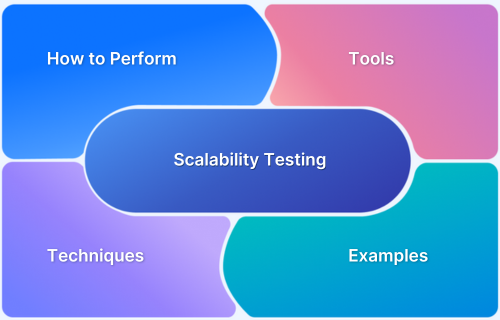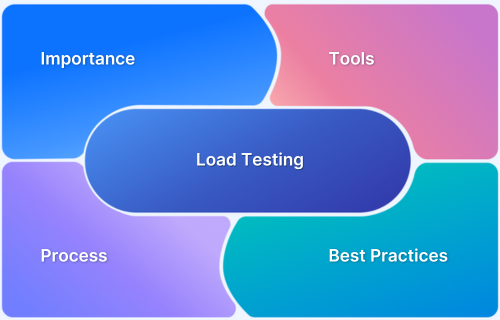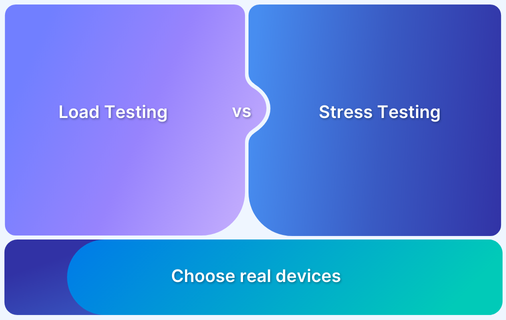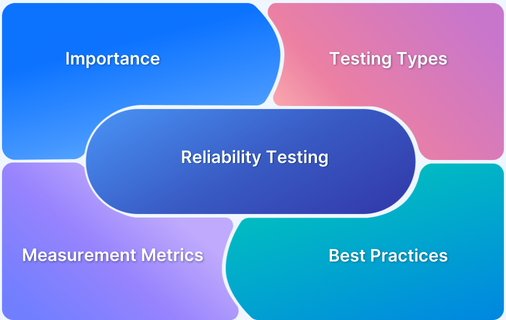Scalability testing ensures an application can handle growing demands efficiently by identifying bottlenecks and optimizing performance.
Overview
Scalability testing evaluates an application’s performance under increasing load to ensure it can handle growth without issues. It helps identify performance limits and optimize resource allocation.
Why is Scalability Testing Important?
- Ensures system stability and reliability under varying loads.
- Identifies performance bottlenecks before production.
- Helps in capacity planning for future growth.
- Improves user experience by maintaining response times.
- Optimizes resource utilization for cost efficiency.
Types of Scalability Testing:
- Load Testing: Measures system performance under expected user loads.
- Stress Testing: Determines how the system behaves under extreme load conditions.
- Horizontal Scaling: Expands capacity by adding more servers or instances.
- Vertical Scaling: Enhances performance by upgrading existing server resources (CPU, RAM, etc.).
Popular Scalability Testing Tools
- Apache JMeter: Open-source tool for load and performance testing.
- Gatling: High-performance, code-based load testing tool.
- K6: Developer-friendly load testing tool with scripting support.
- Locust: Python-based, scalable load testing framework.
- LoadRunner (Micro Focus): Enterprise-grade performance testing tool.
- Tsung: Distributed load testing tool for high concurrency.
- Artillery: Modern, lightweight load testing tool for APIs and microservices.
This article explores scalability testing, its key attributes, importance, techniques, and best tools. It also covers the testing process, real-world examples, and best practices to ensure your application scales efficiently under growing demands.
What is Scalability Testing?
Scalability testing is an area of software performance testing that evaluates the application’s ability to withstand increasing loads without impacting its performance or stability. It is particularly significant as companies and applications expand, inevitably facing unforeseen user demands.
Scalability testing prevents bottlenecks and system architecture vulnerabilities by laying out potential areas where applications may not be able to sustain peak traffic without sacrificing user experience or service quality.
Scalability Testing Attributes
Scalability testing assesses how well a system can respond to increased demands and measures specific performance parameters. These parameters are the benchmarks determining whether applications are still robust, responsive, and resource-efficient as workloads grow.
Key attributes include:
- Response Time: Tracks how quickly the system processes requests under varying loads.
- Throughput: It includes evaluating the number of transactions or requests the system processes per second.
- Latency: Measures delays in processing user requests as load increases.
- Resource Utilization: Monitors CPU, memory, disk, and network usage to optimize performance.
- Concurrent Users: Determines how many users the system can support simultaneously.
- Performance Degradation: Identifies when and how performance declines under heavy loads.
- Scalability Limit: Defines the maximum load the system can handle before failing.
Read More: How to Increase Website Speed
Why is Scalability Testing Important?
Scalability testing is crucial for ensuring applications can handle growing workloads without compromising performance. By proactively testing scalability, businesses can maintain reliability, reduce costs, and support future growth efficiently.
Primary Reasons for Scalability Testing:
- Future-Proofing: It ensures applications can handle surges in traffic or data.
- User Experience: Maintains performance under heavy loads. Google found that 53% of users abandon sites taking longer than 3 seconds to load.
- Cost Efficiency: Identifies resource bottlenecks, optimizes infrastructure, and reduces costs. Cloud providers like AWS charge based on usage, making scalability critical.
- Risk Mitigation: Detects failures before they impact production. For instance, the UK’s NHS COVID-19 booking system crashed in 2020 due to traffic spikes.
- Competitive Edge: Scalable applications outperform competitors. Netflix, for example, handles 200+ million users seamlessly through rigorous scalability testing.
- Business Growth: Supports expansion without system limitations. For example, Shopify scaled to tremendous sales during Black Friday 2020.
Read More: What is Reliability Software Testing
Scalability Testing Techniques
Scalability testing involves various techniques to evaluate different aspects of system performance. Here are the most common ones:
- Load Testing: It forms the backbone for scalability testing, with a focus on defining how a system and application behave under a specified load. It simulates real-world scenarios in order to reveal system bottlenecks and failure points, ensuring apps maintain performance during peak traffic.
- Stress Testing: This testing technique pushes a system beyond its limits to identify breaking points under extreme conditions. It helps the teams identify and fix issues before users notice them.
- Horizontal Scaling: Also known as scaling out, it involves adding more machines or nodes to expand workloads and improve performance. Modern applications are designed to run on cloud-based and distributed systems using multiple servers or containers.
- Vertical Scaling: It enhances resource capacity by upgrading a machine’s CPU, RAM, or storage. This is usually executed in traditional on-premise systems where adding physical resources to a single server is feasible.
Read More: What is Non-Functional Testing?
Best Tools for Scalability Testing
Choosing the right tool is crucial for effective scalability testing. Here are some of the best tools available:
Apache JMeter
Apache JMeter is a popular open-source testing tool that simulates multiple users and measures the performance of web services, supporting both static and dynamic resources. JMeter enables users to create comprehensive test plans and analyzes throughput, latency, and other critical performance metrics across various applications and services.
Key Features:
- Supports HTTP, FTP, JDBC, SOAP, and REST protocols.
- GUI-based test scripting with drag-and-drop functionality.
- Generates detailed reports on latency, throughput, and error rates.
- Distributed testing to simulate massive user loads.
Gatling
Gatling is a high-performance load-testing tool built for scalability testing. It uses a Scala-based DSL (Domain-Specific Language) and provides detailed reports for analyzing performance.
Key Features:
- Scala-based DSL for scripting complex user scenarios.
- Real-time metrics dashboard with interactive graphs.
- Asynchronous architecture for simulating thousands of users with minimal resource use.
- Integrates with Jenkins, Grafana, and CI/CD pipelines.
K6
K6 is a developer-centric, open-source load-testing tool that supports scripting in JavaScript. It’s ideal for testing APIs, microservices, and websites.
Key Features:
- Script tests in JavaScript (ES6+ syntax).
- Built-in CLI and cloud execution for distributed testing.
- Real-time results with thresholds and alerts.
- Supports gRPC, WebSocket, and GraphQL.
Locust
Locust is an open-source, Python-based tool that allows you to define user behavior using code. It’s highly scalable and can simulate millions of users.
Key Features:
- Write test scenarios as Python code (no GUI).
- Distributed load generation across multiple machines.
- Real-time web UI for monitoring tests.
- Lightweight and easy to extend with Python libraries.
LoadRunner (by Micro Focus)
LoadRunner is a widely recognized performance testing tool that offers comprehensive solutions for load and stress testing. It supports various protocols, making it suitable for testing web, mobile, and enterprise systems.
Key Features:
- Supports 50+ protocols (e.g., HTTP, SAP, Citrix).
- AI-powered analytics to predict bottlenecks.
- Cloud-based load generators for global testing.
- Detailed root-cause analysis reports.
Tsung
Tsung is an open-source, multi-protocol tool that supports HTTP, WebDAV, and more. It’s known for its ability to simulate large-scale user loads.
Key Features:
- Supports HTTP, WebDAV, PostgreSQL, and MQTT.
- XML-based configuration for test scenarios.
- Real-time statistics and HTML reports.
- Distributed testing across clusters.
Artillery
Artillery is a modern, open-source tool designed for load testing and scalability testing. It supports scripting in YAML or JavaScript and is ideal for testing APIs and websites.
Key Features:
- YAML/JavaScript scripting for test workflows.
- Built-in support for WebSocket and Socket.io.
- Cloud-native design with Kubernetes integration.
- Extensible via plugins (e.g., for Slack or Datadog).
You must choose tools based on your team’s expertise (e.g., code vs. GUI), protocol requirements, and scalability goals.
Read More: Top 20 Performance Testing Tools
How to Perform Scalability Testing – Process
Performing scalability testing involves a structured process to ensure accurate and actionable results. Here’s a step-by-step guide:
1. Define Objectives: Define clear objectives for scalability testing. It helps to guide the process and prioritize key focus areas.
2. Determine Metrics: Choose top-performing indicators (KPIs). It will give you a glimpse of your system’s performance. Typical metrics are:
- Response Time: How fast does the system respond to user requests?
- Throughput: How many transactions are processed in a particular time interval?
- Resource Utilization: How much CPU, memory, and network resources are being utilized?
3. Choose Tools: Select suitable tools for your scalability testing based on your application needs and the expertise of your team. Some popular tools include Apache JMeter, LoadRunner, and Gatling, all providing different capabilities to support proper testing.
4. Develop Test Scenarios: For more accurate scalability testing, design test cases that replicate real-world traffic patterns, such as sudden spikes from promotions or gradual user growth.
5. Run Tests: Test under a controlled environment. Gradually add load and observe system behavior. It is important to watch how your application behaves under stress and to see any weaknesses.
6. Monitor Performance: Use monitoring tools to track CPU load and response times to gain insights into system performance under different loads.
7. Analyze Results: Analyze test results to identify bottlenecks, failures, and improvement areas. Look for trends indicating issues like slow response times or resource depletion.
8. Optimize and Retest: Make appropriate changes to the system based on your analysis. This might mean optimizing code, upgrading hardware, or tweaking configurations. After changes are made, retest to verify that changes have been successful.
Read More: How to Determine the Right Testing Metrics
Scalability Testing Examples
Here are some real-world examples of scalability testing:
E-commerce Platforms: Testing how a virtual store responds to an influx of traffic during holiday shopping or flash sales.
Etsy has made scalability testing a priority through the incorporation of automation in their CI/CD pipelines. Such automation allows them to make regular updates and better cope with the challenges of resource management and allocation in scalability testing.
Through fine-tuning their test cases and the use of comprehensive documentation, Etsy manages to keep their tests up-to-date and able to accurately represent real-world usage patterns.
Social Media Apps: Evaluating how a social media platform performs when millions of users login simultaneously.
Facebook solves scalability issues through aggressive testing practices that are part of their CI/CD pipelines. They aim to create a test hierarchy that identifies the most critical parts of the codebase and reduces risks caused by badly executed automated tests.
Through open communication and collaboration among teams, Facebook maximizes the efficiency of its scalability testing programs to ensure that potential bottlenecks are addressed in a timely manner.
Streaming Services: Ensuring that a video streaming site is able to provide high-quality content to an increasing amount of users without delay.
Netflix has an exhaustive method of scalability testing in which it keeps track of response time trends, throughput, and resource utilization in order to detect potential problems in its systems.
Automating scalability testing helps them run large tests using more virtual users, which further improves their knowledge regarding system behavior in maximum load. The process followed by Netflix is to identify realistic test cases on the basis of real user experiences and iteratively refine test cases in order to refine scalability results.
Best Practices for Scalability Testing
Here are some best practices for scalability testing that can help maintain performance as your application grows:
- Define Clear Objectives: Start with setting clear goals. Define key metrics like simultaneous users, data volume, and transaction rates. This keeps testing focused on business objectives and user needs.
- Incorporate Real-World Scenarios: Use case simulators that mimic real-use actions like logins and transactions. It helps to identify performance issues and bottlenecks that may be overlooked during simpler test cases.
- Utilize Detailed Metrics: Scalability testing depends on various key performance metrics like error rates, latency, and response time. Analyzing these metrics helps to identify issues and assess the system’s ability to meet user demands.
- Foster Collaboration and Communication: Clear communication among team members streamlines feedback, enhances testing efficiency, and keeps everyone aligned in resolving issues.
- Continuously Monitor and Optimize: Scalability testing should be continuous, not isolated. As software evolves, teams must regularly update testing processes to align with new requirements and maintain performance quality.
- Leverage Automation: Automated testing tools streamline scalability testing by enabling parallel execution, expanding coverage, and speeding up results. With BrowserStack’s real device cloud, teams can run parallel tests on real browsers and devices for faster feedback and broader coverage.
- Ensure Robust Documentation: Comprehensive documentation guides teams through scalability testing. Recording goals, steps, and results keeps everyone informed and simplifies scaling.
Conclusion
Scalability testing is really important in modern-day software development to make sure applications can cater to increasing user demands without compromising their performance.
With the use of various techniques and tools and by adhering to best practices, organizations have come up with means to identify bottlenecks, optimize resource usage, and enhance user experience.
As applications scale, ensuring stability across diverse environments is key. While scalability testing handles the increased load, teams must also validate functionality across real-world conditions.
With BrowserStack, teams can run automated parallel tests across multiple browsers and versions on its real device cloud, which offers 3,500+ real browsers and devices. This enables wider test coverage, accelerates feedback loops, and makes testing more agile, ensuring applications remain robust and responsive as they grow.





